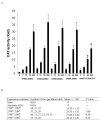GLI1 genotypes do not predict basal cell carcinoma risk: a case control study
- PMID: 19948058
- PMCID: PMC2789726
- DOI: 10.1186/1476-4598-8-113
GLI1 genotypes do not predict basal cell carcinoma risk: a case control study
Abstract
Background: Susceptibility to basal cell carcinoma results from complex interactions between ultraviolet radiation exposure and genetic factors. The GLI1 oncogene is believed to play a role in the genesis of these tumors. We determined whether GLI1 polymorphisms were risk factors for developing basal cell carcinoma, either alone or in combination with patterns of past sun exposure, and whether there were functional differences among different GLI1 haplotypes.
Results: GLI1 genotypes at c.2798 and c.3298 from 201 basal cell carcinoma patients were compared to 201 age and sex-matched controls. Neither genotype nor haplotype frequencies differed between cases and controls. However, the odds of developing basal cell carcinoma on the trunk compared to the head/neck appeared somewhat lower with carriers of the c.3298GC than the CC genotype. There was no evidence for interactions between skin type, childhood sunburning, average adult sun exposure, adult sunbathing, or intermittency of sun exposure and GLI1 haplotype. Additionally, we found no significant differences in transcription activation or cell transforming ability among the four GLI1 haplotypes.
Conclusion: These results suggest that different GLI1 genotypes alone or in combination with past sun exposure patterns as assessed in this study do not affect basal cell carcinoma risk.
Figures

Similar articles
-
Relation between sonic hedgehog pathway gene polymorphisms and basal cell carcinoma development in the Polish population.Arch Dermatol Res. 2016 Jan;308(1):39-47. doi: 10.1007/s00403-015-1612-9. Epub 2015 Nov 21. Arch Dermatol Res. 2016. PMID: 26590974
-
Molecular diagnosis of basal cell carcinoma and other basaloid cell neoplasms of the skin by the quantification of Gli1 transcript levels.J Cutan Pathol. 2005 Feb;32(2):131-6. doi: 10.1111/j.0303-6987.2005.00264.x. J Cutan Pathol. 2005. PMID: 15606671
-
PTCH polymorphism is associated with the rate of increase in basal cell carcinoma numbers during follow-up: preliminary data on the influence of an exon 12-exon 23 haplotype.Environ Mol Mutagen. 2004;44(5):469-76. doi: 10.1002/em.20068. Environ Mol Mutagen. 2004. PMID: 15534865
-
Programmed cell death 1 (PDCD1) gene haplotypes and susceptibility of patients to basal cell carcinoma.Mol Biol Rep. 2021 Mar;48(3):2047-2052. doi: 10.1007/s11033-020-06115-w. Epub 2021 Jan 3. Mol Biol Rep. 2021. PMID: 33389528
-
Gli1 protein is expressed in basal cell carcinomas, outer root sheath keratinocytes and a subpopulation of mesenchymal cells in normal human skin.J Invest Dermatol. 1999 Oct;113(4):595-9. doi: 10.1046/j.1523-1747.1999.00729.x. J Invest Dermatol. 1999. PMID: 10504446
Cited by
-
A population-based study of hedgehog pathway gene variants in relation to the dual risk of basal cell carcinoma plus another cancer.Cancer Epidemiol. 2012 Oct;36(5):e288-93. doi: 10.1016/j.canep.2012.05.001. Epub 2012 Jun 5. Cancer Epidemiol. 2012. PMID: 22677152 Free PMC article.
References
-
- Lear JT, Smith AG, Bowers B, Heagearty AH, Jones PW, Gilford J, Alldersea J, Strange RC, Fryer AA. Truncal tumor site is associated with high risk of multiple basal cell carcinoma and is influenced by glutathione S-transferase, GSTT1, and cytochrome P459, CYP1A1 genotypes, and their interaction. J Invest Dermatol. 1997;108:519–522. doi: 10.1111/1523-1747.ep12289738. - DOI - PubMed
-
- Liboutet M, Portela M, Delestaing G, Vilmer C, Dupin N, Gorin I, Saiag P, Lebbe C, Kerob D, Dubertret L, Grandchamp B, Basset-Sequin N, Soufir N. MC1R and PTCH gene polymorphism in French patients with basal cell carcinomas. J Invest Dermatol. 2006;126:1510–1517. doi: 10.1038/sj.jid.5700263. - DOI - PubMed
-
- Gudbjartsson DF, Sulem P, Stacey SN, Goldstein AM, Rafnar TH, Sigurgeirsson B, Benediktsdottir KR, Thorisdottir K, Ragnarsson R, Sveinsdottir SG, Magnusson V, Lindblom A, Kostulas K, Botella-Estrada R, Soriano V, Juberias P, Grasa M, Saez B, Andres R, Scherer D, Rudnai P, Gurzau E, Koppova K, Kiemeney LA, Jakobsdottir M, Steinberg S, Helgason A, Gretarsdottir S, Tucker MA, Mayordomo JI, Nagore E, Kumar R, Hansson J, Olafsson JH, Gulcher J, Kong A, Thorsteinsdottir U, Stefansson K. ASIP and TYR pigmentation variants associate with cutaneous melanoma and basal cell carcinoma. Nat Genet. 2008;70:886–891. doi: 10.1038/ng.161. - DOI - PubMed
Publication types
MeSH terms
Substances
Grants and funding
LinkOut - more resources
Full Text Sources
Medical
Miscellaneous

